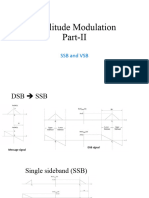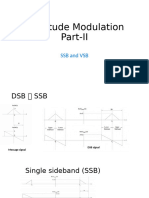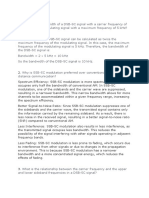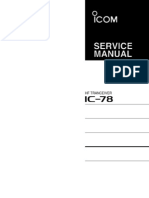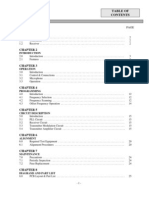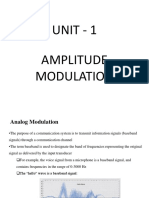0 ratings0% found this document useful (0 votes)
12 viewsCommSys6
Uploaded by
zorotoro7Copyright
© © All Rights Reserved
Available Formats
Download as PPTX, PDF, TXT or read online on Scribd
0 ratings0% found this document useful (0 votes)
12 viewsCommSys6
Uploaded by
zorotoro7Copyright
© © All Rights Reserved
Available Formats
Download as PPTX, PDF, TXT or read online on Scribd
You are on page 1/ 10
بسم الله الرحمن الرحيم
University of Khartoum
B.Sc. of Communication Engineering
4th Year Electrical Engineering
Communications Systems I
EEE 41201
LECTURE 6
EXTRA TOPICS IN MODULATION
Moutaman Mirghani
Institute of Space Research and Aerospace (ISRA)
SINGLE SIDEBAND MODULATION
As mentioned earlier, both DSB-SC and AM signals include LSB
and USB, and AM signal includes the carrier as well. Bandwidth
required is double that of the information signal, i.e. 2 fm.
Efficiency of useful information power indicates its percentage
out of the total transmitted power. For DSB-SC it is 50%, while
for AM it depends on the modulation index, with a maximum
value of 33%.
Both LSB and USB contain the same information. Hence, in
order to save the transmitted power, only one sideband can be
sent, either the LSB or the USB.
This type of modulation is known as Single Sideband (SSB),
which is often used in amateur radio and in tactical mobile
transceivers that operate on batteries. The bandwidth
required equals that of the information signal, i.e. fm.
Similar to DSB-SC signal, SSB signal is to be demodulated
synchronously and cannot be detected using envelope
detector.
In order to generate SSB modulated signals, a direct method
is to filter a DSB-SC signal by a BPF that passes a sideband
and rejects the other.
Since the two sidebands are so close to each other, a very
neat filter like a crystal filter is required to split the two
sidebands. Luckily, speech signals
Speech in standard doisnot
telephony start
300 – 3400 Hz from DC !
Unlike the DSB-SC signal, the time-domain description of SSB
modulated signal is not so straightforward.
which physically is a phase shifter yields a –π/2 phase shift
It involves using complex signals and the Hilbert Transform,
for positive frequencies (and +π/2 shift for negative
frequencies).
The mathematical expression for the SSB signal is
where, is Hilbert Transform of . Minus sign for selection of
LSB, while the plus sign is for USB.
Phase shift and quadrature modulation method is used for
SSB modulation, as shown in the diagram in the next slide.
VESTIGIAL SIDEBAND MODULATION
In VSB type of envelope modulation, one sideband is
transmitted like in SSB, but the other band is not entirely
removed.
A vestige of that sideband is transmitted with a
controlled amount of carrier signal, in order to enable non
coherent demodulation by envelope detector.
As mentioned earlier, SSB is limited for transmission of
voice signals. However, VSB commonly is used in TV
broadcast since video contains DC.
At the TV receiver, an envelope detector acts as video
detector. The demodulated video signal contains also FM
voice subcarrier.
MULTIPLEXING OF SIGNALS
If several baseband signals (such as speech signals) are mixed to
be sent through same communication channel, it will be difficult to
separate them at the other end.
After modulation of each baseband signal, it is frequency-
translated to the carrier frequency.
Therefore, if each of the modulated signals is of a different carrier
frequency, they can be multiplexed (mixed together) and sent
through same channel, and demultiplexed at the other end.
This type of multiplexing of signals is known as Frequency Division
Multiplexing (FDM), where channel bandwidth is divided.
How can we demultiplex those mixed signals ?
At the receiving end, a bank of BPFs is used to demultiplex FDM
signal, each of them is of a center frequency equals to that of
one of the carriers.
Bandwidths of those bandpass filters classically are identical.
However they can be of different bandwidths.
What will be the next stage after demultiplexing ?
So as to retrieve baseband signals, such as voices of telephone
subscribers via trunk line, demodulation is to be done for those
demultiplexed signals. Again, it is not necessary for all signals
to use the same modulation scheme, such as AM or SSB.
FDM is used in satellite communication by multiplexing signals
of different transponders (TPs) of different frequencies and
send them using a single antenna, and receive them at the
ground station with the same dish antenna.
You might also like
- JA Meshal Alotaibi: Background of DSB-AMNo ratings yetJA Meshal Alotaibi: Background of DSB-AM4 pages
- Lesson 5 - Single Sideband System: ECE121 - Principles of CommunicationsNo ratings yetLesson 5 - Single Sideband System: ECE121 - Principles of Communications67 pages
- Question#1: Why DSB-SC Is Most Frequently Used. Answer:: It Stands For Double-Sideband Suppressed-Carrier SystemNo ratings yetQuestion#1: Why DSB-SC Is Most Frequently Used. Answer:: It Stands For Double-Sideband Suppressed-Carrier System3 pages
- Assignment#1: Principles of CommunicationsNo ratings yetAssignment#1: Principles of Communications4 pages
- Advantages of Single Sideband Suppressed CarrierNo ratings yetAdvantages of Single Sideband Suppressed Carrier2 pages
- Single-Sideband Modulation: Single-Sideband Modulation (SSB) Is A Refinement of Amplitude Modulation That MoreNo ratings yetSingle-Sideband Modulation: Single-Sideband Modulation (SSB) Is A Refinement of Amplitude Modulation That More5 pages
- Double Side Band - Suppressed Carrier (DSB-SC) AND Single Side Band100% (1)Double Side Band - Suppressed Carrier (DSB-SC) AND Single Side Band55 pages
- Lecture 7 Amplitude Modulation - II - PPTX - Day1No ratings yetLecture 7 Amplitude Modulation - II - PPTX - Day137 pages
- Modulation Systems Used in Satellite Communications100% (1)Modulation Systems Used in Satellite Communications15 pages
- Communication System TC-307: Lecture 10, Week 4 Course Instructor: Nida NasirNo ratings yetCommunication System TC-307: Lecture 10, Week 4 Course Instructor: Nida Nasir86 pages
- COMMUNICATION SYSTEM - Module-2 - Part2No ratings yetCOMMUNICATION SYSTEM - Module-2 - Part226 pages
- Types of Amplitude Modulation and Areas of Applications: Report TitleNo ratings yetTypes of Amplitude Modulation and Areas of Applications: Report Title9 pages
- Single-sideband_Suppressed-carrier_Modulation_and_ (1)No ratings yetSingle-sideband_Suppressed-carrier_Modulation_and_ (1)10 pages
- Real Time DSP-AM - Transmitter - Tamir SulimanNo ratings yetReal Time DSP-AM - Transmitter - Tamir Suliman11 pages
- Communication System Eeeb453 Amplitude Modulation: Dept of Electrical Engineering Universiti Tenaga NasionalNo ratings yetCommunication System Eeeb453 Amplitude Modulation: Dept of Electrical Engineering Universiti Tenaga Nasional18 pages
- 6.Single-Sideband Communications SystemsNo ratings yet6.Single-Sideband Communications Systems22 pages
- Introduction To Communication System Chapter Two Analog Modulation Techniques100% (2)Introduction To Communication System Chapter Two Analog Modulation Techniques47 pages
- Term Paper: ELE-102 Electrical Sciences-IiNo ratings yetTerm Paper: ELE-102 Electrical Sciences-Ii17 pages
- Amplitude Modulation-DSBSC, Single Sideband and Vestigial Sideband250% (2)Amplitude Modulation-DSBSC, Single Sideband and Vestigial Sideband220 pages
- Analog Modulation: Analysis and SimulationNo ratings yetAnalog Modulation: Analysis and Simulation6 pages
- AM Independent and Vestigial Sideband SummaryNo ratings yetAM Independent and Vestigial Sideband Summary6 pages
- 1) Double Sideband Full Carrier (DSBFC)No ratings yet1) Double Sideband Full Carrier (DSBFC)28 pages
- Japan Test Report: Report No.: JR1D0705AC Page No.: 1 of 16 Report Version: Rev. 01No ratings yetJapan Test Report: Report No.: JR1D0705AC Page No.: 1 of 16 Report Version: Rev. 0168 pages
- A Yagi-Uda Antenna For MURS and 2-MetersNo ratings yetA Yagi-Uda Antenna For MURS and 2-Meters4 pages
- AM Detection With Automatic Gain Control: C M H D DNo ratings yetAM Detection With Automatic Gain Control: C M H D D2 pages
- Digital Microwave Communication OverviewNo ratings yetDigital Microwave Communication Overview15 pages
- Lesson 5 - Single Sideband System: ECE121 - Principles of CommunicationsLesson 5 - Single Sideband System: ECE121 - Principles of Communications
- Question#1: Why DSB-SC Is Most Frequently Used. Answer:: It Stands For Double-Sideband Suppressed-Carrier SystemQuestion#1: Why DSB-SC Is Most Frequently Used. Answer:: It Stands For Double-Sideband Suppressed-Carrier System
- Single-Sideband Modulation: Single-Sideband Modulation (SSB) Is A Refinement of Amplitude Modulation That MoreSingle-Sideband Modulation: Single-Sideband Modulation (SSB) Is A Refinement of Amplitude Modulation That More
- Double Side Band - Suppressed Carrier (DSB-SC) AND Single Side BandDouble Side Band - Suppressed Carrier (DSB-SC) AND Single Side Band
- Modulation Systems Used in Satellite CommunicationsModulation Systems Used in Satellite Communications
- Communication System TC-307: Lecture 10, Week 4 Course Instructor: Nida NasirCommunication System TC-307: Lecture 10, Week 4 Course Instructor: Nida Nasir
- Types of Amplitude Modulation and Areas of Applications: Report TitleTypes of Amplitude Modulation and Areas of Applications: Report Title
- Single-sideband_Suppressed-carrier_Modulation_and_ (1)Single-sideband_Suppressed-carrier_Modulation_and_ (1)
- Communication System Eeeb453 Amplitude Modulation: Dept of Electrical Engineering Universiti Tenaga NasionalCommunication System Eeeb453 Amplitude Modulation: Dept of Electrical Engineering Universiti Tenaga Nasional
- Introduction To Communication System Chapter Two Analog Modulation TechniquesIntroduction To Communication System Chapter Two Analog Modulation Techniques
- Amplitude Modulation-DSBSC, Single Sideband and Vestigial Sideband2Amplitude Modulation-DSBSC, Single Sideband and Vestigial Sideband2
- Japan Test Report: Report No.: JR1D0705AC Page No.: 1 of 16 Report Version: Rev. 01Japan Test Report: Report No.: JR1D0705AC Page No.: 1 of 16 Report Version: Rev. 01
- AM Detection With Automatic Gain Control: C M H D DAM Detection With Automatic Gain Control: C M H D D













